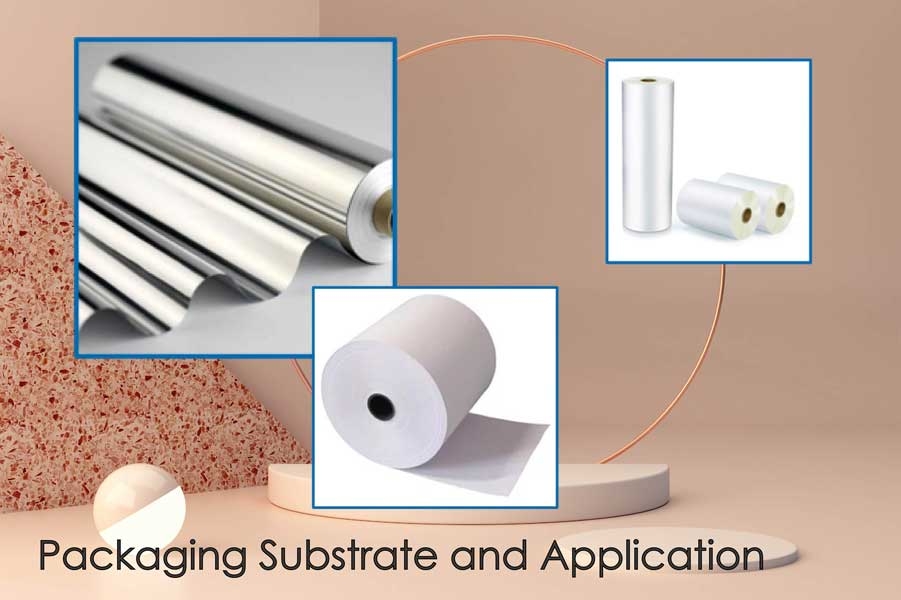Packaging Substrate and Application

Flexographic printing is one of the major printing processes adopted for packaging. The packaging across various industries such as food and beverages, FMCG, pharmaceutical, health, cosmetics, industrial, agriculture…etc. In this article, we will be exploring the 3 major substrates (materials) that are used in packaging including paper, metallic film, and plastic film.
Paper
The attributes of the paper substrate include surface characteristics, color, brightness, opacity, basis weight, grain direction, tensile strength, and tearing strength. Surface characteristics – paper has a wire side and a felt side. The surface characteristic of the felt side is usually whiter than the wire side, and is more receptive to ink, producing a better luster in the final product. Color – the color of the paper will affect how the ink performs on the surface. Brightness – when the paper is produced, the reflective rate of the paper will be measured. The higher the reflective rate indicates a higher paper grade. Opacity – measures the amount of light that goes through the paper. The text and image printed on a high opacity paper will be seen through on the other side, where a lower opacity paper will prevent the text and image from penetrating to the other side. Basis weight – usually measured based on 500 sheets of standardized paper. For instance, when 500 sheets of 25 x 38 inches paper weigh 80 pounds, its basis weight will therefore be 80 pounds. Grain direction – the grain direction will affect the flatness and smoothness of the paper. Badly aligned grains in the paper may cause issues such as mottling during printing. Tensile strength – the tensile strength indicates how much strength can the paper fiber take on before breaking, it is usually measured in Newton Force / mm. Tearing Strength – measures the strength that the paper can take before tearing when forces are applied in the opposite direction. This test is conducted on both the horizontal side and vertical side of the paper.
Metallic Film
The most common metallic film adopted is aluminum foil. Aluminum is an excellent barrier towards light, ultraviolet, water, water vapor, and air. Aluminum has a good stiffness and visually provides a metallic luster. Aluminum is widely adopted in the pharmaceuticals, dairy, and food packaging industries. The setback of aluminum is its fragility. It has a weak tensile strength and a weak tear strength. Furthermore, It cannot be hot sealed in packaging. Due to these weak properties, aluminum is rarely used as a standalone. It is usually laminated with other substates during application.
Plastic Film
There are many categories of plastic film. The major category includes PE, PP, PET, Nylon, PVDC, PVC, and EVOH. Under the PE category, there are different variations that include LDPE, MDPE, HDPE, LLDPE, and MLLDPE. PE is the most common plastic in use today. Its primary application is for plastic bags, containers, and bottles. The PE class tends to be low in strength, hardness, and rigidity. It has good chemical resistance properties and absorbs almost no water. The PP category is the second most widely produced plastic after PE. PP is more economical to produce, tends to be more thermal resistant, and has a better transparency when compared to PE. However, it does not stand up to low temperature and chemical as well as the PE. Due to PP’s fatigue resistance and heat resistance property, it is commonly used in flip-top bottles, lids, and food containers, where repetitiveness is required and needs to stand up to heat without melting. There are two main types of PET, the BOPET, and CPET. The PET class is odorless and has good luster, strength, hardness, and rigidity. Is resistant to forces such as puncture, rubbing and is resistant to both high and low temperature. It is a very good material to use as a barrier. However, its is a costlier material to produce. PET is commonly used in packaging foods, food that can be warmed in the oven or microwave, bottles for drinks, and containers for sanitary products. Nylon has good strength and rigidity. At the same time, it has good flexibility and resistance to puncture. However, it absorbs water. Therefore, it is suitable for packaging products that require resistance to force and less resistance to humidity and water. PVDC and PVC are remarkable barriers against water, oxygen, and aromas. It has superior chemical resistance to alkalis and acids, is insoluble in oil and organic solvents. Commonly used in food preservation. EVOH has a very good resistance to oils and organic solvents. Therefore, it is commonly used in packaging greasy food products. It is also good for acting as a barrier toward gases like oxygen, nitrogen, and carbon dioxide. However, EVOH loses its good gas barrier properties when exposed to moisture.
Nowadays different types of resins are coextruded, and different types of plastic films, metallic films, and paper are laminated together to optimize for both cost and performance. The different lamination methods include wet lamination, dry lamination, solventless lamination, extrusion lamination and hot melt lamination. Where, dry lamination is commonly used in forming a combination of film on film, film on foil, and film on paper. Wet lamination is more often applied to paper products. To achieve lamination for paper on paper, paper on paper board and paper on foil.
The first step to successful packaging is to know your substrates. To understand the pros and cons of the substrate. To understand its mechanical property, chemical property, and visual property. How well would it perform with your printing ink and your downstream converting process? To evaluate all these factors so that you can obtain a suitable packaging for the product.

Article by Daywey Chen, KYMC


























